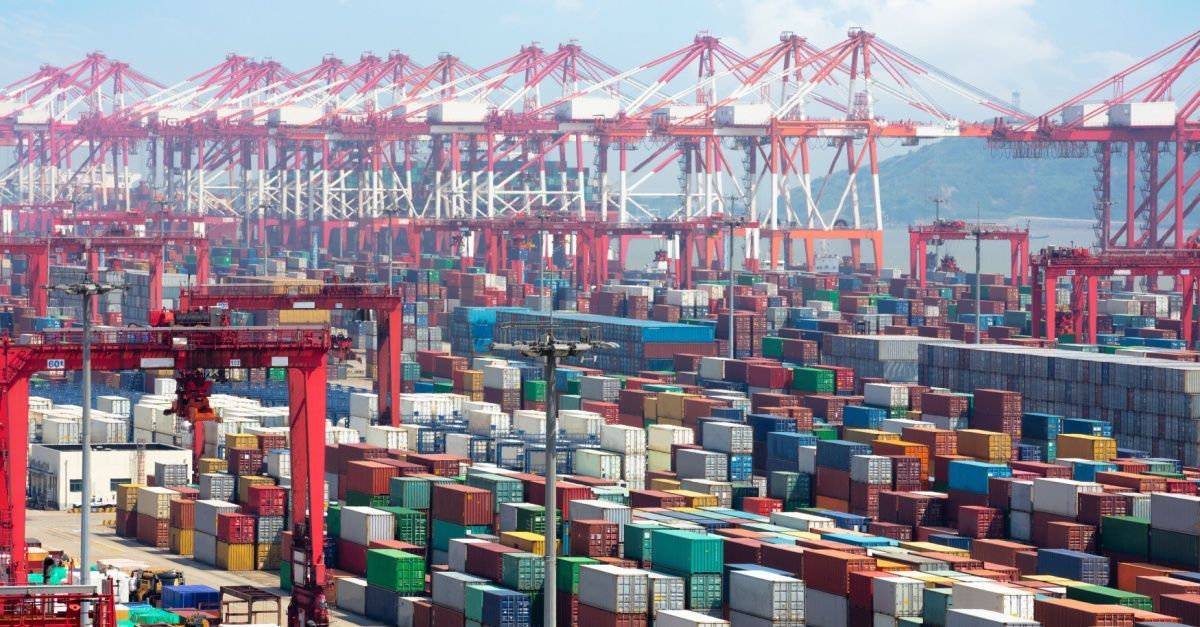Trucking Rates Hold as Orders Plunge and Tariff Threats Continue
Blog Post CTA
May brought a fresh wave of operational recalibration across the U.S. logistics, retail, and manufacturing sectors.
Freight market stakeholders are
navigating intensifying pressures tied to tariffs, regulatory uncertainty, and shifting consumer sentiment. Carriers are struggling to match revived trans-Pacific demand, while the LTL market holds pricing power amid broader freight softness. At the same time, truck makers are scaling back forecasts as uncertainty clouds the industrial outlook.
We have compiled critical developments defining the freight world and reshaping commercial strategy for global supply chain operations. From record LTL prices to license violations and retaliatory tariff risks, there is a lot in store in this edition of the EFS newsletter.
Truck Rates Expected to Hold Steady Despite Import Surge
A surge in U.S. imports during the 90-day tariff pause is boosting ocean rates, but the surge is unlikely to affect truckload and drayage pricing, according to analysts at Truckstop and FTR Transportation Intelligence. Despite stronger inbound flows at ports, truck capacity remains abundant, 35% higher than in 2019, blunting any upward pressure on rates.
While some drayage drivers may shift to spot truckload, most surface freight markets remain stable. April saw increased load activity in hubs like Atlanta, Dallas, and Phoenix, but national dry van spot rates hovered around $1.60 per mile, with little change year over year.
Logistics providers like AFS and ITS Logistics expect some rate movement in June, but not enough to spark a freight rebound. Without broader economic catalysts, front-loaded imports are unlikely to reverse the freight recession that began in 2022. Analysts say tariffs alone don’t generate demand, and the market remains consistent, if soft, for now.
Truck Orders Plunge Amid Tariff Pressures, Market Uncertainty, and Rising Prices
U.S. Class 8 truck sales fell 9.4% year over year in Q1, with 50,627 units sold, as OEMs faced a mix of freight market softness, tariff uncertainty, and rising input costs. Although overall orders dropped sharply, April bookings plunged 52.1% year over year, per ACT Research.
Major manufacturers like Daimler, Volvo, and Paccar cut 2025 outlooks, citing weak demand and the impact of the Trump administration’s tariffs, including new 25% duties on steel and aluminum. Only Mack saw growth, with orders up 108%, driven by vocational truck demand.
Fleet caution, emissions rule uncertainty, and material price hikes contributed to a gloomy outlook. Layoffs followed: VTNA, Mack, and International cut more than 1,900 jobs in Q1. Daimler now forecasts 260,000-290,000 truck sales in North America for 2025, down from earlier expectations of 280,000-320,000.
Executives warn that tariffs and shifting policy will likely suppress new truck orders through the end of 2025.
EU Tariff Threat Raises Costs, Risks Reshoring Goals
According to logistics and trade experts, President Trump’s proposed 50% tariff on EU goods risks inflating production costs for U.S. manufacturers and straining a critical trade relationship. While Trump accuses the EU of trade barriers and manipulation, critics argue the proposed tariff could backfire by raising prices on industrial components essential to U.S. manufacturing.
Andy Abbott, CEO of Atlantic Container Line, said the EU supplies goods for U.S. production, unlike Asia’s consumer-driven exports, making higher tariffs counterproductive to Trump’s reshoring agenda. Analysts warn that reduced EU imports would also raise container rates for U.S. exporters, increasing outbound costs and hurting competitiveness.
Recent recovery in ocean freight bookings from Europe could stall if tariffs are imposed, while retaliatory EU measures remain a looming threat. Legal experts say Trump may also target Apple through a broader national security review of tech imports.
While the administration aims to pressure the EU on agriculture and digital trade, many believe achieving consensus will be difficult amid diverging interests across the 27-member bloc.
4% of US Truckers Lack Valid CDL, Raising Alarms Over Safety
A new analysis shows that roughly 4% of truck drivers operating on U.S. highways at any time lack a valid commercial driver’s license (CDL).
Based on FMCSA roadside inspection data, the figure highlights a regulatory gap with major safety implications, especially for vehicles exceeding 26,000 pounds or transporting hazardous materials. 2025 data also shows a 56.4% violation rate across inspected trucks and a 19.3% out-of-service rate, mirroring recent years.
In Q1 alone, there were 645 fatal truck crashes, each carrying an average economic cost of $7.2 million, according to insurance data. Consequences for unlicensed operation include fines, jail time, and suspensions, depending on the infraction. Trucking expert Adam Wingfield suggests the push to fill seats amid perceived driver shortages may have compromised safety standards.
Industry leaders argue for tougher enforcement, saying improved compliance could reduce fatalities, raise industry professionalism, and increase trucking rates due to reduced capacity, ultimately making U.S. roads safer for everyone.
LTL Pricing Holds at Peak as Truckload Market Stays Depressed
U.S. LTL pricing remains at record levels, with the Bureau of Labor Statistics’ PPI holding at 259 from February through April, equal to its June 2022 peak. Rates are up 12.1% from July 2023 following Yellow’s collapse and 4.9% year over year.
This surge corresponds with Q1 contract renewals, with
LTL carriers reporting mid-single-digit rate hikes. The LTL PPI tracks total costs to shippers, including surcharges and accessorials, not just base rates. Tariff-related demand fluctuations have had little impact on LTL pricing so far.
In contrast, the truckload market remains soft. The truckload PPI fell in April and is now 24.6% below its May 2022 high. Despite a 2.7% increase in LTL terminals last year, LTL capacity remains tighter than in truckload, which continues to face excess carrier volume, 37% more than in 2019.
This divergence reflects structural shifts as LTL firms hold pricing power while truckload carriers compete in a saturated spot market.
Walmart Leads Tariff-Driven Price Hikes, Warns More Increases Coming
Walmart confirmed it will raise prices in late May and early summer as tariff-hit goods reach shelves. CFO John David Rainey called the speed and scale of cost increases “unprecedented.” Some hikes, like bananas rising to 54 cents a pound, are already in effect.
While the recent U.S.-China deal reduced tariffs from 145% to 30%, Walmart warned that even the lower rate will significantly impact prices. Sales remained strong, with U.S. comparable
sales rising 4.5% in the quarter ending May 2. However, Walmart withheld a profit forecast, suggesting it may absorb some costs to stay competitive.
CEO Doug McMillon praised the White House for progress but urged further reductions. As retailers, including Target, Lowe’s, and Home Depot, prepare to report earnings, Walmart’s actions signal broader pricing pressure across the sector. The retailer plans to selectively adjust prices while leaning on private labels and advertising to protect margins.
Target Q1 Sales Dip 3.1% Amid Tariff Pressures, Consumer Backlash, and Exec Turnover
Target’s Q1 2025 merchandise sales fell 3.1% year over year to $23.4 billion, with overall comps down 3.8%, led by a 5.7% drop in store sales, partially offset by 4.7% digital growth. Despite a 13.6% rise in operating income, the retailer cut its full-year outlook from growth to a low-single-digit sales decline.
CEO Brian Cornell cited falling consumer confidence, tariff uncertainty, and backlash to diversity policy rollbacks as key headwinds. Tariff mitigation has included supplier negotiations, sourcing shifts, and selective pricing adjustments.
Target announced a new Enterprise Acceleration Office to speed execution, led by COO Michael Fiddelke, alongside major leadership exits — including Chief Strategy Officer Christina Hennington and Chief Legal Officer Amy Tu.
Analysts criticized Target’s missteps in inventory and customer service, noting the company’s strategic reset, including a five-year merchandising revamp and new Shipt delivery perks, will take time to gain traction. For now, the retailer faces uphill challenges in a softening economy.
Entourage Freight Solutions: Food-Grade Expertise for All Your Shipping Needs
Our roots run deep in food service logistics, and our expertise and track record speak for themselves. At Entourage Freight Solutions, we’ve built our reputation on handling perishable and sensitive shipments with the utmost care and precision. This dedication to service and attention to detail extends to every shipment we touch -- perishable or not.
We believe in total transparency. That is why we invest in tech solutions that extensively track every shipment, monitor every driver, and squeeze out every bit of efficiency without sacrificing quality. Our state-of-the-art platform uses cloud-based GPS tracking to keep you informed, reroutes shipments on the fly to avoid delays, and even reacts to real-time market changes to ensure you’re getting your shipment on time and as soon as possible.
Our Services
- Full Truckload (FTL): When you need a truck all to yourself.
- Less-Than-Truckload (LTL): Efficient solutions for multi-stop shipments or combining smaller loads to save on costs.
- Refrigerated Trucking: Keeping your temperature-sensitive products fresh and safe.
- Cross-Docking: Strategically located facilities in Shelby, Ohio, Cedar Rapids, Iowa, and Romulus, Michigan, for streamlined consolidation, storage, and distribution.
Ready to experience a new level of service and control in your freight shipping? Request a quote today to see how Entourage Freight Solutions can help with your freight movement and other supply chain needs.









